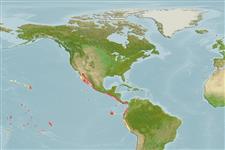Environment: milieu / climate zone / depth range / distribution range
Écologie
marin démersal; profondeur 0 - 300 m (Ref. 9269), usually 0 - 95 m (Ref. 9269). Subtropical; 34°N - 15°S
Eastern Pacific: Santa Catalina Island, southern California, USA to Peru.
Taille / Poids / Âge
Maturity: Lm ? range ? - ? cm
Max length : 33.0 cm TL mâle / non sexé; (Ref. 55763); common length : 15.0 cm TL mâle / non sexé; (Ref. 55763)
Description synthétique
Clés d'identification | Morphologie | Morphométrie
Épines dorsales (Total) : 3; Rayons mous dorsaux (Total) : 12 - 14; Épines anales: 0; Rayons mous anaux: 8 - 9; Vertèbres: 19. Branchiostegal rays: 6 (Ref. 36491).
Adults inhabit rocky areas, including the intertidal zone. Found on sandy and muddy bottoms (Ref. 9269). Young individuals feed heavily on crustaceans but as they grow bigger, they consume more and more fish, sometimes catching and eating fishes their own size (Ref. 4930).
Life cycle and mating behavior
Maturité | Reproduction | Frai | Œufs | Fécondité | Larves
Eschmeyer, W.N., E.S. Herald and H. Hammann, 1983. A field guide to Pacific coast fishes of North America. Boston (MA, USA): Houghton Mifflin Company. xii+336 p. (Ref. 2850)
Statut dans la liste rouge de l'IUCN (Ref. 130435: Version 2024-1)
Menace pour l'homme
Harmless
Utilisations par l'homme
Outils
Articles particuliers
Télécharger en XML
Sources Internet
Estimates based on models
Preferred temperature (Ref.
123201): 15.7 - 28.8, mean 23.3 °C (based on 270 cells).
Phylogenetic diversity index (Ref.
82804): PD
50 = 0.5312 [Uniqueness, from 0.5 = low to 2.0 = high].
Bayesian length-weight: a=0.02630 (0.01029 - 0.06725), b=2.96 (2.73 - 3.19), in cm total length, based on LWR estimates for this (Sub)family-body shape (Ref.
93245).
Niveau trophique (Ref.
69278): 4.0 ±0.66 se; based on food items.
Résilience (Ref.
120179): Haut, temps minimum de doublement de population inférieur à 15 mois (Fec assumed to be > 10,000).
Fishing Vulnerability (Ref.
59153): Low vulnerability (23 of 100).
